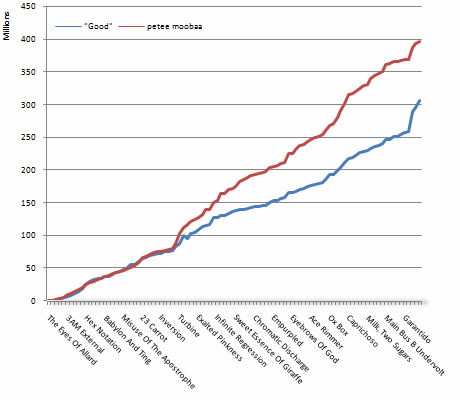The earliest reference to Rez I can remember reading was had Jeff Minter denouncing its gameplay, claiming it was “Panzer Dragoon with trance trousers.” Which meant nothing to me, until I snaffled Panzer Dragoon Orta on the recommendation of an Edge review. At that time, I had little-to-no understanding what a rail-based shooter was all about – but Orta sure taught me all about it. I still love the occasional bash at Orta (which, due to the Hard mode and all the fiddly little mini-games – and the original Panzer Dragoon – is still on The List), and it sparked an interest in the genre.
And then I recalled Minter’s words.
Rez, eh?
I already had a Dreamcast – Jet Set Radio forced my hand in that direction. A bit of eBaying led to a pricey, but mint, copy of Rez. Then came a period of days where I learnt all about the dodgy GD-ROM pressing that led to most Dreamcasts being unable to read the Rez discs. Worry not – it’s possible to adjust the GD-ROM laser (similar to the C64 Datasette’s azimuth adjustment) to read finicky discs; a bit of hardware hacking, a lot of time, a smidgeon of panic when the Dreamcast failed to read any discs, and finally Rez was booted.
And fuck me if it wasn’t magnificent.
The first level, Area 1, will go down as one of my favourite levels of any game ever – purely for the aural accompaniment. I feel like I’ve written this a million times before, but the sonic punch provided when you enter Areas 1-4 and 1-8 – “breathing” – has attained almost spiritual significance to me; the choice of Buggie Running Beeps as this (almost tutorial) level’s soundtrack is inspired. Visually, Area 1 provides a trippy introduction too.
But Area 4 is the one that I love the most (and yes, I realise this means that Rez has two of my favourite game levels ever – but I feel obliged to give credit where credit is due). For a long time Area 4 gave me grief – it was my stumbling block, the one that made me feel uneasy. But, with two years of hindsight, it’s also the level that excites me the most – I find the graphics to be the most arresting of the game (even over Area 5, which is the reason most people give for Rez‘s greatness) – the Running Man boss is simply incredible. Joujouka’s soundtrack is edgy, driving you on through the level with rising levels of adrenaline and concern, building to a thumping crescendo; end-to-end, it’s a wonderful level, surpassing Area 1’s dull boss and Area 5’s introspective length. Area 4 is simply a miracle of gaming, one of the few times that the audiovisual experience is all-enveloping, all encompassing.
And yes – I do have the Trance Vibrator for my PS2 copy of Rez (a far less pristine version of the game, I might add; a most-definitely second-hand eBay acquisition, the PS2 version makes the hacking rainbows more colourful). Whilst my SO looked at me with what can only optimistically be described as quizzical indifference when I indicated Game Girl Advance’s Rez exploits, I found that it was a brilliant addition to the game – playing the PS2 version, Trance Vib behind a cushion nestled into the small of my back, was a sublime experience.
And so we come to 2008, and the long awaited release of Rez HD – and I’ve never been more excited about a game’s release, never felt so much anticipation. Having to travel for work determined the release date, with 2,000kms deemed an attractive torture device by Fate. Whilst others were blissfully playing through Area 1, I was half-drunk; I lay on my bed in the dark and listened to the soundtrack rips that have accompanied me everywhere on my MP3 player for the last 4(-ish) years. The backs of my eyelids glowed with the recreation of the visual experience that I know all-too-well, yet not well enough; Areas 1 and 4 came alive for me.
The plane ride home Saturday night was nominally two-and-a-half-hours, but felt much longer; I listened to that soundtrack again, over and over, while clouds and land and sea drifted below me. The plane only had a smattering of passengers, so I was unabashed in weeping with joy, weeping with anticipation, grinning like a loon – for I was on my way to play Rez again. A bigger, bolder, brighter, louder Rez.
I got home, kissed the SO, and played.
Oh yes. Oh yes.
But more on that later. Another day, when typing is easier because the tips of my thumb (which prove to be ever-so-useful for hitting the space bar) ache so much from the mashing I’ve given them the last 24 hours. Easily my best Score Attack scores, and even a miraculous 98% run through Area 5. I love this game.
But I’ll leave with this little tale:
When I had my little jaunt around the UK in 2004, the RLLMUK rips of the Rez soundtrack never left my MP3 player. Not once. Pretty impressive when you consider that it was only a 512MB player. There were so many dream-like instances where I’d be coasting through the English countryside – by train, bus – and have sunlight streaming through the window onto my face, the greens and whites and blues passing by, enveloped in a state of bliss. At those times I’d often reflect, a little self-indulgently, that this life I was leading was just a game, a game that – like so many others – I was only moderately “good” at, but I was having an absolute ball playing. And Rez provides the perfect soundtrack, the perfect metaphor, for that game of life.
